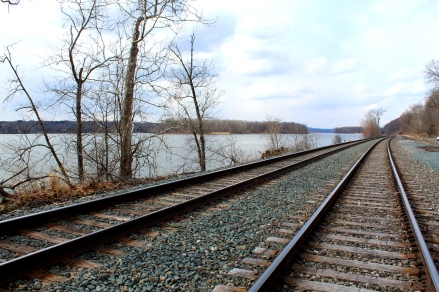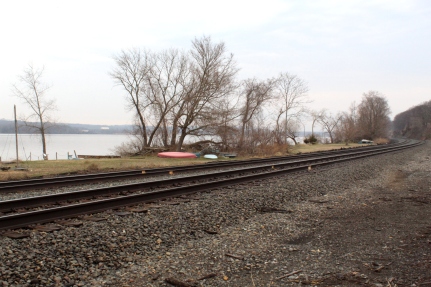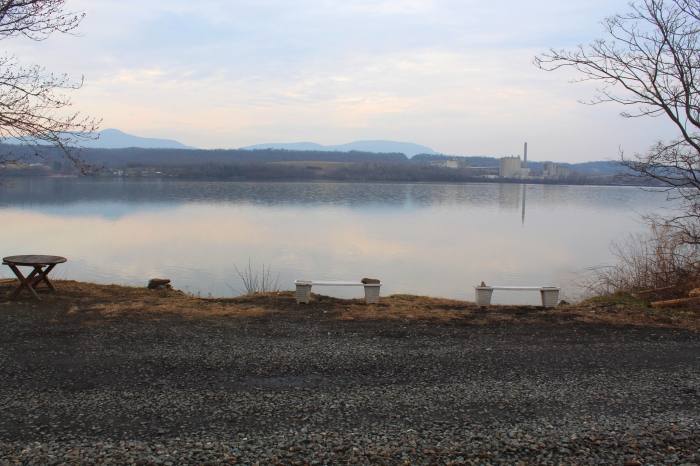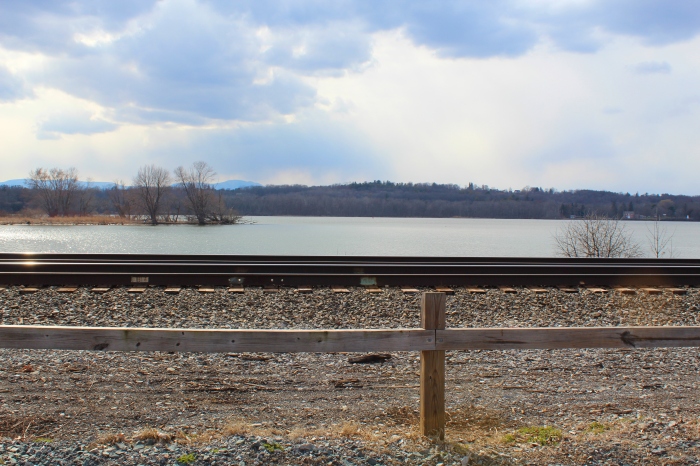Amtrak plans to install a series of gates and more than a mile-and-a-half of fencing along the east side of the Hudson River to keep “trespassers” seeking to enjoy the river off its land.
The construction is planned in eight locations in five communities — Rhinebeck, Tivoli, Germantown, Stockport and Stuyvesant — to “keep pedestrians and vehicles out of harm’s way,” according to Amtrak.
The fencing would seek to funnel those trying to access the river to official crossings in some areas and block all pedestrian access in others, while the gates would mostly seek to block vehicles from driving along the Amtrak maintenance road located between the tracks and the river, according to the plan, which must be approved by the New York State Department of State (DOS) in order to move forward.
The tracks are owned by freight transporter CSX, but are being leased by Amtrak, which maintains them. The tracks abut the river through much of their journey up the Hudson Valley.
However, riparian enthusiasts — the river rats — along the Hudson are pushing back at the proposal, writing letters, holding meetings, and demanding more transparency from Amtrak about the plans.
The River Rats
Bird-watchers, kayakers, joggers and swimmers cross the tracks in areas proposed to be blocked, but the group most affected by Amtrak’s plans are fishers.
A rough Amtrak maintenance road careens between the tracks and the Hudson River through Germantown, Tivoli and Rhinecliff, and the road has been used by anglers seeking to hook striped bass during the spring run for generations, said William Shannon, the spokesman for the Germantown Waterfront Advisory Committee, which is coordinating efforts to resist Amtrak’s plan.
“The last week or two of April and the first week or two of May, the access road along the railroad is like a public thoroughfare,” he said.
Gating off the access road would “majorly impact fishermen,” Shannon said.
“Striped bass is the only thing the Hudson River has left in terms of a big run of fish that people still get excited about,” he added.
Friction between those wanting to access the Hudson in Germantown and the various railroad companies that have controlled the tracks has periodically bubbled up since the tracks were laid in the 1850s, Shannon said.

The Hudson RIver waterfront and Amtrak rails in Stockport. Amtrak plans to install a 350-foor fence to the right of the tracks in order to keep “trespassers” from crossing the tracks on their way to the river.
Amtrak controls the land its tracks run over, and therefore anyone on the land without permission is technically trespassing. Amtrak refers to river rats crossing the tracks in non-designated areas as “trespassers” in its proposal.
However, river rats commonly bump into Amtrak workers while using the maintenance road, and, instead of friction, the two groups chat about fishing.
Not one person interviewed for this article knew of any instances of the workers demanding “trespassers” leave. They instead described a friendly “don’t ask, don’t tell” relationship between the two groups.
Kaare Christian, who owns property on the river side of the tracks in Germantown, said he often uses the maintenance road.
“I talk to the train crews all the time,” he said. “If one of the Amtrak pickup trucks comes by, they generally stop and talk, and they never say, ‘Get out, you’re in a dangerous spot, and we’re worried about your safety,’ they say, ‘Nice day.’”
Other than a couple instances of people setting off fireworks over the river, Christian said he hadn’t experienced trouble with the trespassers since he moved in 30 years ago.
How Dangerous, Really?
Amtrak wrote in its application to the DOS the fences and gates were being erected to protect pedestrians and vehicles from being hit by trains while illegally crossing the tracks.
Cars are able to cross over the tracks and onto the maintenance road on “at-grade crossings” that are supposed to only be used by authorized vehicles.
Statistics maintained by the Federal Railroad Administration are sketchy, as they do not pinpoint the exact location of accidents between trains and pedestrians or vehicles illegally crossing the tracks.
Because of this, information on train-trespasser collisions are not available for the length of affected tracks in Dutchess County. However, the statistics do point to occasional fatal collisions between trains and trespassers in Columbia County.
Over the last 20 years, there have been five fatal train collisions involving trespassers in Columbia County, and two in which trespassers were injured, according to the data.
However, the data does not state whether the collisions happened on the rail line in Amtrak’s proposal, or on two other rail lines in the county, nor do they reveal if the collisions happened in the areas Amtrak plans to alter.

Boats and docks along the Hudson River in Germantown, where Amtrak plans to build a 700-foot fence to block river rats from crossing their tracks to the river.
The fencing and gates would have had no effect on the last trespasser-train collision the data lists, which happened last year in Chatham, when a tow truck that had parked on the tracks while trying to deal with an unrelated accident was hit, injuring the driver, according to The Register-Star.
A prior collision listed in the data could have arguably been avoided with the proposed fences, however.
The collision, which killed a Philmont man, happened on the tracks in Stockport, according to the Albany TImes-Union, at a location Amtrak wants to erect a fence.
Shannon said the Germantown Waterfront Advisory Committee was also concerned about safety, though he added he, nor any Germantown fire or EMS personnel, were aware of anyone being hit on the tracks in the municipality.
His safety concerns were not directed at the maintenance road, but at a length of track in Germantown running parallel to lower Main Street. The area is a traditional crossing point to the Hudson, Shannon said, and several docks are visible on the water.
Amtrak wants to install a 700-foot fence along the tracks to block access to the area, according to the proposal.
“We do share the concerns about safety, but we want there to be a sustainable solution,” Shannon said, such as a pedestrian bridge over the tracks, which the waterfront committee has looked into.
Germantown Supervisor Robert Beaury said it was unfortunate for Amtrak to categorize the anglers and bird-watchers seeking to access the Hudson as “trespassers.”
“I don’t want to give the impression that it’s an issue for the town — it’s not,” he said.
Beaury, a former Germantown High School teacher, said he has no institutional memory of anyone being struck by a train at any of the spots in Germantown Amtrak is proposing to block off.
At the same time, “we cannot argue against safety,” he said.
However, Beaury expressed concern about a safety issue the proposed gates might actually create.
With gates blocking vehicles from driving up and down the maintenance road, first responders would have trouble getting to emergencies on the Hudson, he said.
Tivoli Mayor Joel Griffith shared Beaudry’s concerns, as the Amtrak maintenance road is also gated off in his town in Amtrak’s proposal.
“Our emergency [services] absolutely have to be able to get big vehicles to the water’s edge, so we would need keys (to the gates), because our fire and rescue squads go out on the river for boating accidents [and] for forest fires on some of the islands,” he said.
The Tivoli Fire Department responds to emergencies down at the Hudson several times a year, Griffith said.
A Lack of Communication
The issue of emergency responders getting keys to the proposed gates is very much up in the air, Griffith said, simply because there has been no communication from Amtrak about the plans.
Both Griffith and Beaury said they had many unanswered questions about the plan due to the skimpy and vague proposal submitted to the state.
Amtrak did not tell the towns about the proposal, and town officials learned about it from the DOS. Griffith and Beaury said Amtrak has been completely uncommunicative about their plans.
As well as questions about emergency personnel’s access to the maintenance road, the town leaders had questions about the size of the fences and gates, as well as their precise location.
The original state-mandated comment period for the project was expanded from 15 days until the end of April after public pressure, but stakeholders have demanded Amtrak hold information sessions in all the towns affected.
This demand has come from several town supervisors and Hudson River advocacy organizations, as well as state Assemblywoman Didi Barrett and state Senator Kathy Marchione, whose districts encompass the affected towns.
Amtrak has not responded to the requests.

Benches along the Amtrak maintenance road in Germantown, which the rail company wants to block off with gates to stop its use by unauthorized vehicles.
Up to The State
Scenic Hudson, a nonprofit environmental group that has created more than three-dozen public parks from Yonkers to Greene County, penned a joint letter with environmental advocacy organization Riverkeeper to the state asking for the information sessions, as the proposal “would reduce public access to the Hudson River and negatively impact viewsheds,” according to the letter.
Only after the sessions are held should the public comment period begin, the letter states.
Jeffery Anzevino, Scenic Hudson’s director of land use advocacy, said limiting access to the Hudson RIver was “terrible,” and was part of the railroad’s history of “building tracks and walling off, so to speak, the waterfront from communities, up and down the river from New York (City) to the Capital District.”
Nature-philes who flock to the Hudson — Anzevino affectionately calls them “River Rats” and considers himself one of them — would be cut off from the river if the plan went through, he said.
The DOS must approve Amtrak’s plan, Anzevino said.
“[Amtrak] has to demonstrate — and the New York State Department of State needs to agree with it — that there is no conflict with any of the state’s coastal management policies,” he said.
There are 44 of these policies, Anzevino said, and public access to the Hudson would be the policy the proposal would most infringe upon, though an argument could also be made the fencing would block the Hudson from view, another one of the policies.
The Germantown Waterfront Advisory Committee is holding a “Fight the Fences” rally at Lasher Park in Germantown on April 22 to protest Amtrak’s plan. Beaudry, the Germantown Supervisor, said he supports the rally and the town is making their facilities available, including providing buses to transport protestors to the park, though the protest is not officially endorsed by the town government.
April 22 is Earth Day.




Pingback: Alternative Proposed to Amtrak’s Plan Cutting Off Hudson Access
Pingback: Amtrak Pulls Plan to Fence Off Parts of Hudson River